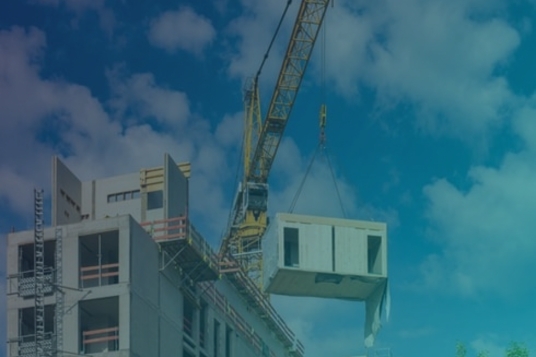
- Construction & Infrastructure
Construction Problems? Solve it by Building Modularly

We have good and bad news for the construction industry in the Netherlands. The good news: there is plenty of work due to the housing shortage. The bad news? We cannot solve this by building alone. A shortage of personnel and the nitrogen problem, among other things, require attention. Modular construction can offer a solution, but this requires a critical re-evaluation of the processes at construction companies.
Traditional construction can be briefly summarized as: you bring together construction workers, stones and a construction drawing on location until you can deliver a house. Modular construction radically changes this approach. The house is built as far into the factory as possible. A handful of construction workers assemble the modules on location.
Modular construction has the advantages:
- You need fewer people on the construction site, so that the tightness on the labor market is less of an obstacle.
- You are no longer so dependent on the weather, which means you can deliver faster and more reliably.
- You can extensively automate the manufacturing process, which reduces the risk of errors.
- Air-conditioned areas increase quality and construction speed.
- Standardized modules allow you to build more efficiently.
- You reduce the consumption of materials and promote circularity.
From project-based to modular construction
To benefit from the benefits of modular construction, changes are required in the way of working. Traditionally, construction works on a project basis. After accepting the assignment, the project team determines which materials are needed and who will be collaborated with. Project management involves the delivery of goods and services and the progress of construction is monitored.
With a modular approach, the focus shifts from construction to the factory. Because standard modules are used as much as possible, multiple projects can run together. It is also possible to utilize economies of scale across projects and use stocks more intelligently with other purchasing strategies. The deployment of people and the use of equipment and machines can also be planned more efficiently, provided that automation supports this.
The elevator shaft as an example of modular construction
In the Netherlands and Germany, among others, you can already see various examples of working with modular construction. For new buildings, for example, an elevator shaft is cast in concrete on location. This construction serves, as it were, as a hook on which to 'hang' the other parts of the building. Spaces arrive on special transport to the construction site and are attached to the elevator shaft. Once the 'block box' is in place, the facade will surround the building. The outer shell makes it one whole.
A new approach with appropriate ERP support
The new approach to modular construction requires a reconsideration of ERP support. The processes in modular construction are structured differently than in traditional construction. This also requires a different method of construction supervision. It is therefore essential to support the processes in modular construction with a suitable ERP system. Within the construction world, suppliers of temporary buildings can serve as an example. The processes there have already been set up to install ready-made modules on location.
The right digital support from the manufacturing industry
Established construction companies would be wise to look not only at the flexible construction industry, but also at other sectors. For example, there are all kinds of digital support techniques available within the manufacturing industry that allow companies to put their own stamp on standard products. Consider processes that support Make to Order (MTO), Customize to Order (CTO) and Engineer to Order (ETO). These process techniques are of great importance to support modular construction.
Build, move and reassemble
For example, a company like ASML personalizes machines on behalf of the customer. After manufacture, a lithography machine is transported in parts and reassembled on location. We must admit that a high-tech device is not the same as a family home, but the concept is similar. The customer adapts a home module. It is built in the factory, is sent to the desired location in parts, where it is assembled and further completed
Building more efficiently in the factory
By moving the majority of the construction work from the construction site to the factory, work is much more efficient. Because you control the climate in a factory, drying times can be better controlled and you lose less time due to weather influences. Optimization of production also leads to less material loss. This in turn provides positive side effects. For example, a reduction in material consumption also entails a reduction in nitrogen emissions.
Modular prefab contributes to circularity
In the longer term, modular prefab contributes to circular construction. If (part of) a home is no longer needed at one location, you can theoretically move the modules to another location. Of course, flexibility should not be forgotten. When building homes, you always want to give the customer room for wishes, requirements and options. By anticipating this in advance and setting up the right processes, you can immediately meet these conditions.
Construction problems? Switch to modular housing
The shortage of housing in the Netherlands can be largely solved by switching to modular housing. This requires adjustments to the processes at construction companies. The flexible construction industry and the manufacturing industry can serve as work planners. By making smart use of developments that they are already deploying, construction companies can move faster.
Get in touch
Ready to make a business change? At Emixa, we'd be glad to share our comprehensive insights. Contact us to discover how our approach can help your organization thrive in the cloud era. Let's embark a journey towards enhanced efficiency and effectiveness together!

Albert van Engen
Albert van Engen has been an expert in Product and Quality Management for over 20 years. With a 'sharp' view of customers' organizations, he focuses on their business processes every time. He is continuously looking for improvement actions and is focused on SAP innovations and their implementation.
Author: Albert van Engen
Published date: August 26, 2025

Explore our Technology. Access our downloads center.
Access NowStart your Digital Transformation with Emixa

We help businesses transform their digital future with cutting-edge technology and strategic products & services


